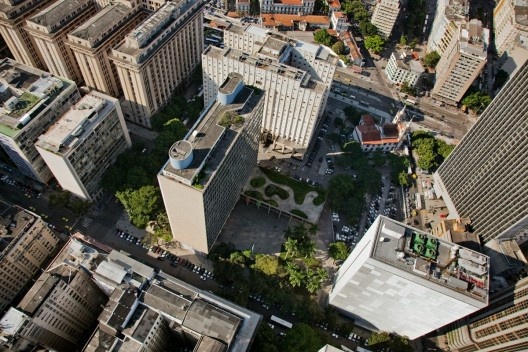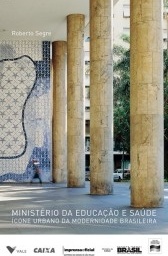Architects, researchers and Brazilian critics found many ways to try to define the uniqueness of a certain office building built inRio de Janeiroin the late 1930s. It hosted the Ministry of Health and Education (MES in its Portuguese acronym), the Ministry of Education and Culture, called now the Palácio Gustavo Capanema. Lúcio Costa credited the headquarters of the MES to be the revelation of the genius of architect Oscar Niemeyer, which in itself would have a special recognition in the historiography of Modern architecture. But Lúcio Costa also stated that it was “[…] a project that would belong to [...] the general history of fine arts as a lasting mark of a new and fruitful cycle of the timeless art of building. It was indeed in this building of considerable size – carried out with such care and full comprehensive conceptual purity – where, for the first time, it was possible to carry out the main ideas that 25 years before the creative genius of Le Corbusier had presented with the passion, the fearlessness and the faith of a true crusader. Of all the seeds that he had generously thrown all over the world [...] this one, left here, [...] was the one, after all, that in fact avenged” (1).
For Carlos Eduardo Comas the palace is “prototype and monument”(2), Ruth Verde Zein considers it a “mandatory quote, frame of any historical approach of Modern Brazilian architecture” (3); for Mauricio Lissovsky and Sergio de Sá “ born monumentally, the construction of this building immediately assumes a mythological character” (4), Italo Campofiorito says the building is “graceful, gentle and strong [...] touched with elegance, delicacy and force [...] a perfect portrait of Modernism when Young” (5). The authors of Le Corbusier and Brazil (6) referred to it saying that “from the invitation to provide feedback on the project of the MEC in Rio de Janeiro the roles of teacher and students” redefined itself to make a new “Modern and Brazilian” architecture. The bold entrepreneurship and autonomy of Brazilian students annoyed the European Master: “How have these youngsters managed to do, in a country like Brazil, what I was not able to do here in Europe?” (7) The incident came to undermine the relationship between teacher and students when Le Corbusier, disagreeing when credited as project consultant, committed the “slip” of publishing in Ouvre Complete, 1934–1938, “a sketch made a posteriori based on photos of the built building”, pointing out Lúcio Costa in correspondence: “(you) publish (the sketch) as if it were an original design, (which) caused a sad impression” (8).
The formula that Roberto Segre found in order to summarize all the previous ones and that will suit the title for the book that will review, complete and delve into the story of this Modern palace – clarifying once again the authorship issue among many others – was “urban icon of Modernity”. To understand and situate a debate that had gone on for so many years – and that was only exposed in final consensus with critics and Brazilian researchers – Roberto Segre assembled a team of collaborators. He then undertook a life that would arise, as he explains in the Introduction, from his passion for the city ofRio de Janeirowhere he established himself as a researcher and professor in 1994. He also continued with his other passion, the architecture of Le Corbusier, which had aroused when he was a young Italian architecture student immigrant inBuenos Aires.
The academic research started in 1998 became the book Ministério da Educação e Saúde – ícone urbano e modernidade brasileira in 2006. Two years later Segre was appointed responsible of the application of the Palácio Gustavo Capanema as a World Heritage Site, a long standing claim that the Brazilian government has not yet presented to Unesco. It could even complement the 1987Brasilia entry since the city was accepted primarily as it represented “un événement majeur dans l’histoire de l’urbanisme” (9).
In 1948, the MES was listed by the Brazilian Office for National Artistic and Historical Heritage, as national heritage. Just three years after its opening – anticipating its unusual uniqueness as a monument and the issues surrounding the protection of Modern Movement architecture – the building was inscribed in the book Livro do Tombo das Belas Artes, as “it was the first monumental building aimed at public services’ headquarters, ever planned and built worldwide in strict compliance to the principles of Modern architecture” (p. 456-457).
The Palácio Gustavo Capanema – named after Getulio Vargas’ Minister who played a key role in the recruitment of the carioca architects, in bringing Le Corbusier to Brazil and in the viability of the project – was designed by a team of young architects then composed by Lúcio Costa (1902–1998), Carlos Leão (1906–1983), Oscar Niemeyer Soares Filho (1907–2012), Affonso Eduardo Reidy (1909–1964), Ernani Vasconcellos (1912–1989) and Jorge Machado Moreira (1904–1992). Le Corbusier participated as a consultant. Other partners who joined were Roberto Burle Marx (1909–1994), responsible for the design of the green areas, and artists Candido Portinari (1903–1962), who designed the tiles and executed murals; Bruno Giorgi (1905–1993), Jacques Lipchitz (1891–1973), Adriana Janacópulos (1897–1978), and Celso Antônio (1896–1994), author of the numerous sculptures that populate the building, plus the engineer Emilio Baungart responsible for the structural calculations.
The beginning of the long process that includes the design and construction of the palace was marked by the launch of an official competition for the new headquarters for the Ministry of Health and Education in April 1935, and its subsequent annulment. It continued with the appointment of the Modern Movement architects and artists, the coming of Le Corbusier toRio de Janeiroin 1936, and with the laying of the cornerstone of the building in April 1937. It ended with the official opening onOctober 3, 1945. These ten years faced the difficulties of economic and political contradictions that marked the government of Getulio Vargas; years lived in the context of World War II in Europe; and the cultural clashes that made the work of the MES a privileged field to weigh up between the academic tradition and the avantgarde art, both confronted since the 1920s in Brazil.
In 544 pages and 945 reference notes, the teams of the author of the book, Roberto Segre, and Publisher Editora Romano Guerra, articulate and organize bibliographic sources, and reveal and publish documents, thus casting new light on the debates surrounding the long gestation of monumental Modernity in Braziland showing the headquarters of MES from different sides. The first one emphasizes the role of the building in the transformation of the city of Rio de Janeiro. Located in a new area of expansion, the project discusses the provisions of the development plan devised by the French Urbanist Donat Alfred Agache for Rio de Janeiroin 1927. It breaks with the classical proposal of compact occupation with blocks to release an important space of land for gardens and pedestrian circulation under pilotis.
The development of the design, in all its phases, is dissected and scrutinized by posting sketches, drawings, photographs and texts, explaining compositional, constructive and even conservation and restoration issues. In the presentation of the book, Jean-Louis Cohen draws attention to some of these aspects, such as the fact that the headquarters of MES usher in a new type of skyscraper, establishing not only a lexical rupture – with the use of brise-soleils and the corbusian matrix of pilotis – but a structural rupture referring to the elongated plant, the decentralized core and the flat roof crowning the volume.
During a trip toBrazilin 1936, Le Corbusier writes the text “L’architecture et les Arts Majeurs” (10) – aboard the Zeppelin airship – which he entrusts to Lúcio Costa when he returns toFrance. There he develops his ideas, still embryonic, on the possibility of an effective relationship between the three major arts – architecture, sculpture and painting – and these with other means of expression. Among other principles, the MES implements and inaugurates the Synthesis of Arts mainly through the themes of the works of art associated with the design and use of the traditional blue and white tile panels. From this dialogue between the arts appears the seed of the characteristic Brazilian nascent Modern architecture of Rio de Janeiro: “[...] the very national character is expressed through architectural collaboration of authentic artists, thus preserving what is imponderable, but genuine and irreducible in the differentiated character of each people” (11).
By illuminating the path through the most remote corners of the Palácio Gustavo Capanema, the research now published unveils some of its mysteries, clarifies old doubts and raises new ones. It points to the importance of the debate about Modern architecture, while it also confirms an old suspicion: as for most palaces regarded as milestones in the history of exceptional architecture, the existence of this Modern palace can be regarded as a happy occasion which brought together the power and the determination of a Prince, Minister Gustavo Capanema, and the genius and intelligence of an artist, architect Lúcio Costa.
notes
NE
Original publication in English: SANTOS, Cecilia Rodrigues dos. Revisiting the headquarters of the Ministry of Education and Health in Rio de Janeiro. Docomomo Journal, n. 49, vol. 2, 2013/2.
1
COSTA, Lúcio, “Carta a Gustavo Capanema datada de 3 out. 1945”. In LEONIDIO, Otavio “Lúcio Costa: palavra definitiva”, I Enanparq, Rio de Janeiro, 2010, <http://www.anparq.org.br/dvd–enanparq/simpo-sios/138/138–794–1–SP.pdf>.
2
COMAS, Carlos Eduardo Dias. Protótipo e monumento, um ministério, o ministério. Projeto, São Paulo, n. 102, August 1987.
3
VERDE, Ruth Verde, “Segundo a ordem das razões e mais além”, editorial do número especial da Revista Projeto dedicado ao centenário de Le Corbusier, August 1987, n. 102.
4
LISSOVSKY, Mauricio; SÁ, Sergio M de, “Mais vale saber de Le Corbusier que conhecê-lo aos pedacinhos”. Projeto, August 1987, n. 102. By the same authors: LISSOVSKY, Maurício; SÁ, Paulo Sérgio Moraes de. Colunas da educação: a construção do Ministério da Educação e Saúde. Rio de Janeiro: Minc/Iphan/Fundação Getúlio Vargas/CPDOC, 1996.
5
Ítalo Campofiorito interviews Hugo Segawa, Projeto, August 1987, n. 102.
6
SANTOS, Cecilia Rodrigues dos; PEREIRA, Margareth da Silva; PEREIRA, Romão da Silva; SILVA, Vasco Caldeira da. Le Corbusier e o Brasil, São Paulo, Tessela/Projeto, 1987.
7
Carmem Portinho interviews Hugo Segawa, Projeto, August 1987, n. 102.
8
Letter from Lúcio Costa to Le Corbusier, 27/11/49, FLC, C1.18.76 a 78. Apud SANTOS, Cecília R. dos, et alt. Op. cit.
9
La liste du Patrimoine mondial: Brasilia. Unesco, Paris, 1987 <http://whc.unesco.org/fr/list/445>.
10
LE CORBUSIER. “A arquitetura e as Belas-Artes – As tendências da arquitetura racionalista relativamente à colaboração da pintura e da escultura. O estudo da tendência que, ao contrário, impera na arquitetura racional de excluir como supérfluo, seguindo uma lógica rigorosa, o concurso das artes figurativas”. Translated by Lúcio Costa and published for the first time in Revista do Patrimônio Histórico e Artístico Nacional, Rio de Janeiro, Iphan, n. 19, 1984, p. 53-69.
11
COSTA, Lúcio. “O arquiteto e a sociedade contemporânea”. In XAVIER, Alberto (org). Lúcio Costa: sobre arquitetura, Porto Alegre, Editora UniRitter, 2007, p. 2.
about the author
Cecilia Rodrigues dos Santos PhD Architect and Researcher Faculdade de Arquitetura e Urbanismo Universidade Presbiteriana Mackenzie, São Paulo, Brazil.






